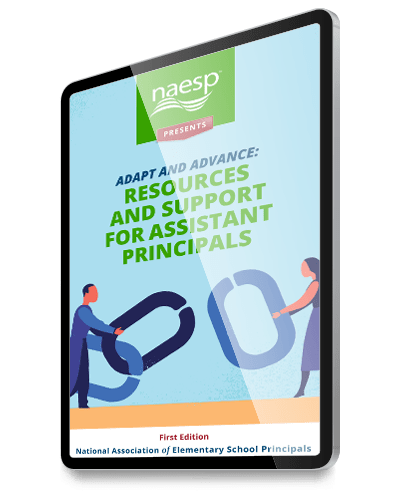
The Assistant Principal’s Impact Is Rising
Foreword to NAESP’s new ebook for assistant principals contextualizes new research about the role.
Topics: Assistant Principals
The assistant principal role is rising in stature and impact. There are more assistant principals in U.S. public schools than ever before, according to “The Role of Assistant Principals: Evidence and Insights for Advancing School Leadership,” the landmark 2021 report from Vanderbilt University and Mathematica commissioned by The Wallace Foundation. But while the principal’s role is similar from district to district, the AP’s role and career path is anything but standardized.
Even Vanderbilt University Professor Ellen Goldring, lead author on the report, was surprised to find a lack of uniformity in the AP’s role and responsibilities. “So many schools have assistant principals today, and it is such a linchpin in leadership development,” Goldring told NAESP’s Principal magazine. “But we really don’t know that much about it. [There’s a] lack of clarity around strategic resource allocation.”
Assistant principals and principals often share the same basic set of tasks—so much so that their job descriptions may look very much alike. Responsibilities vary from school to school and team to team, but whether they concentrate on administration, discipline, instructional leadership, or a little bit of everything, the AP largely fills in the blanks designated by the
school principal based on the school’s needs and the AP’s observed strengths.
Always Adapting
Educational leaders who want to make a positive impact on student outcomes must have skills and expertise in supporting instruction, managing and developing people, and organizational management, says another Wallace-commissioned report, “How Principals Affect Students and Schools.” But APs must have adaptive skills and flexibility to grow and cultivate these
skills on the fly. Many challenges will include aspects that traditional preparation programs can’t predict or address.
“The things you learn in a preparatory program really can’t prepare you for real-life situations,” said Alicia Flores, associate principal at Vista Square Elementary School in Chula Vista, California. “We don’t get the practice until we’re at a site and faced with a challenge.”
Elusive Standards
Most states and districts don’t have distinct professional standards for assistant principals and principals, “The Role of Assistant Principals” found, making it challenging to prepare APs to move into the principalship. When there is a job description, it often states the obvious: The AP will “assist,” “help,” and otherwise “support” the principal.
Traditionally, APs have been charged with discipline and spend a majority of their time on related duties, while the principal concentrates on instructional leadership and administration. But the more recent the study, the more varied the AP’s tasks are, Goldring and her colleagues, Ellen Mollie Rubin and Mariesa Herrmann, found. Today’s assistant principals are more likely to dabble in every aspect of school operations.
For example, Aqila Malpass spent more than half of her time on instructional leadership when she served as AP of Rocky Ridge Elementary School in Hoover, Alabama. “I can’t dedicate 100 percent of my attention to curriculum and instruction,” said principal Dilhani Uswatte. “That is a great responsibility, and I want[ed] Aqila to wear that hat.”
APs and Apprenticeship
Much as districts and states don’t often delineate a recommended distribution of tasks between principal and assistant principal, they rarely state whether the AP’s role should be seen as a sort of understudy or apprenticeship for the principalship. It’s often up to the principal, the district, and the APs themselves to create that path.
“It can be a stepping stone in the sense of learning from a seasoned principal while growing your leadership capacity,” Phillips said. “The roles assigned to the AP should be good preparation for the principalship if they involve instructional leadership tasks—including PD—that transcend discipline issues and lunch duties.”
Assistant principals may keep busy with tasks related to discipline, scheduling, staffing, testing coordination, and facilities management. But assistant principals who want to move up say they appreciate on-the-job training in instructional leadership, finance and budgeting, and assessment of school performance—all primary tasks of a building leader.
Ongoing Development
Professional learning opportunities intended to help APs master their current roles or move further down the path to the principalship are not widely available, according to “The Role of Assistant Principals.” In a nationally representative 2015 survey of U.S. public school principals, only 36 percent reported that their districts provided APs with professional learning other than mentoring or coaching at least monthly.
While a principal can contribute to the AP’s development by exposing them to every aspect of building leadership, ambitious APs must be prepared to direct their own enrichment. This may mean taking a greater role in school improvement planning, initiating new projects, shadowing other building principals, or participating in aspiring principal cohorts.
“Each individual needs to take charge of their own situation and their own career, however difficult that may be,” Goldring said. “Be ‘planful’ and clear about those goals. Seek out mentoring and support; social networking is important. Being open to learning is the key—putting yourself in opportunities where you can take risks. If you want to be a principal, [you need] the opportunity to engage in a broad swath of leadership responsibilities.”
NAESP Supports Assistant Principals
With what we know about the role of the assistant principals and their particular needs, the National Association of Elementary School Principals has dedicated its resources to developing an ecosystem of support that can begin to fill the voids in preparation and ongoing professional learning described above. What we’ve learned from assistant principals—and those who support them—has been poured into the APs Rising resource series (articles, blog posts, podcasts, webinars, Twitter chats, etc.) and the Assistant Principal Community of Practice.
NAESP’s new ebook, Adapt and Advance: Resources and Support for Assistant Principals, offers educators an in-depth look at the AP role, the pathways it offers into school leadership, advice on developing the skills and expertise needed to succeed, and its effect on student outcomes, equity, and school effectiveness. Using it, current and aspiring APs can better understand their roles, making what can seem like a monumental task—building a successful career that makes a positive impact on students and schools—a little less daunting.
Kaylen Tucker is associate executive director, Communications, at NAESP, and editor in chief of Principal magazine.
This article was originally published as the Foreword to Adapt and Advance: Resources and Support for Assistant Principals.

Download Adapt and Advance: Resources and Support for Assistant Principals

